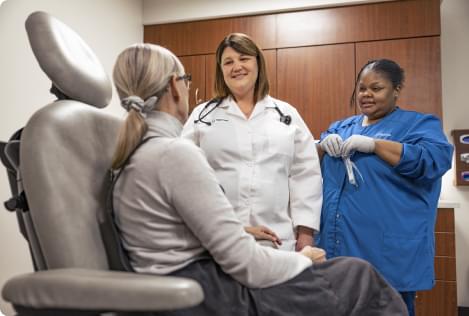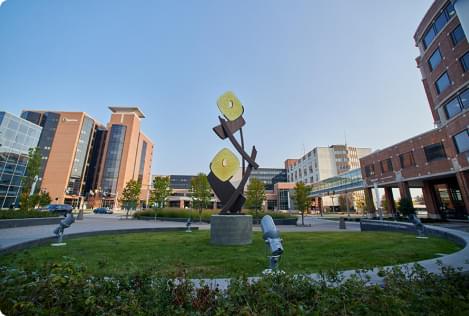Overview
A testicle that doesn't move down into its proper place in the scrotum before birth is called an undescended testicle. It's also known as cryptorchidism (krip-TOR-kih-diz-um). Most often, it's just one testicle that doesn't descend into the scrotum, which is the bag of skin that hangs below the penis. But sometimes both testicles are affected.
An undescended testicle is more common in premature babies than it is in full-term infants. An undescended testicle often moves down on its own within a few months after the baby is born. If your baby has an undescended testicle that doesn't correct itself, surgery can be done to move the testicle into the scrotum.
Symptoms
Not seeing or feeling a testicle in the scrotum is the main symptom of an undescended testicle.
Testicles form in an unborn baby's lower belly. During the last few months of pregnancy, the testicles typically move down from the stomach area. They move through a tubelike passage in the groin, called the inguinal canal, and descend into the scrotum. With an undescended testicle, that process stops or is delayed.
When to see a doctor
An undescended testicle often is found during an exam done shortly after birth. If your baby has an undescended testicle, ask how often exams will need to be done. If the testicle hasn't moved into the scrotum by 3 to 4 months of age, the condition likely won't correct itself.
Treating an undescended testicle when your child is still a baby might lower the risk of health problems later in life. These include cancer of the testicles and not being able to get a partner pregnant, also called infertility.
Older boys — from infants to preteens — who have descended testicles at birth might appear to be missing a testicle later. This might be a symptom of:
- A retractile testicle, which moves back and forth between the scrotum and the groin. The testicle might be easily guided by hand into the scrotum during a physical exam. A retractile testicle is due to a muscle reflex in the scrotum.
- An ascending testicle, which has returned to the groin. The testicle can't be easily guided by hand into the scrotum. Another name for this is an acquired undescended testicle.
Talk to your child's doctor or other member of their care team if you notice any changes in your child's genitals or if you have other concerns.
Causes
The exact cause of an undescended testicle isn't known. Genes, the health of the baby's mother and other factors might have a combined effect. Together they may disrupt the hormones, physical changes and nerve activity that play roles in how the testicles develop.
Risk factors
Things that might raise the risk of an undescended testicle in a newborn include:
- Premature birth or low birth weight.
- Family history of undescended testicles.
- Health conditions in the baby, such as cerebral palsy or a problem with the wall of the abdomen.
- The mother having diabetes before or during pregnancy.
- Alcohol use during pregnancy.
- Smoking cigarettes or exposure to secondhand smoke during pregnancy.
- Exposure to some pesticides during pregnancy.
Complications
The testicles need to be slightly cooler than regular body temperature to develop and work well. The scrotum provides this cooler place. Complications of a testicle not being located where it's supposed to be include:
-
Testicular cancer. Men who've had an undescended testicle have a higher risk of testicular cancer. This disease often begins in testicle cells that make immature sperm. It's not clear why these cells turn into cancer.
The risk is greater in men who've had undescended testicles located in the stomach area than in men who've had undescended testicles in the groin. The risk also is higher when both testicles are affected. Surgery to correct an undescended testicle might lower the risk of testicular cancer. But the cancer risk doesn't go away completely.
- Fertility problems. These problems make it harder to get a partner pregnant. They're more likely to happen in men who've had an undescended testicle. Fertility problems might be worse if an undescended testicle goes without treatment for a long time.
Other health conditions linked with an undescended testicle include:
- Testicular torsion. This is the twisting of the cord that brings blood to the scrotum. It's a painful problem that cuts off blood to the testicle. Without quick treatment, the testicle might become so damaged that it needs to be removed with surgery.
- Trauma. If a testicle is in the groin, it might get damaged from pressure against the pubic bone.
- Inguinal hernia. A part of the intestines can push into the groin through a weak spot in the muscles of the stomach area. The bulge this causes can be painful.
Diagnosis
With an undescended testicle, surgery may be needed to find the problem and treat it. There are two main types of surgery:
-
Laparoscopy. A small tube with a camera on it is placed through a small cut in the belly. Laparoscopy is done to locate a testicle in the stomach area.
- Open surgery. This uses a larger cut to look inside the stomach area or groin to find the undescended testicle.
The surgeon might be able to fix the undescended testicle during the same procedure. But another surgery might be needed. Sometimes, laparoscopy might not find an undescended testicle. Or it might find damaged or dead testicle tissue that doesn't work, and the surgeon removes it.
If a baby's testicles can't be found in the scrotum after birth, more tests may be needed. These tests can determine if the testicles are absent — meaning not there at all — rather than undescended. Some health issues that lead to absent testicles can cause serious problems soon after birth if they're not found and treated.
Imaging tests, such as an ultrasound and MRI, usually aren't needed to find out if a baby has an undescended testicle.
Treatment
The goal of treatment is to move the undescended testicle to its proper place in the scrotum. Treatment before age 1 might lower the risk of health problems linked with an undescended testicle, such as infertility and testicular cancer. Earlier treatment is better. Experts often recommend that surgery take place before the child is 18 months old.
Surgery
Most often, an undescended testicle is fixed with surgery. The surgeon moves the testicle into the scrotum and stitches it into place. This is called orchiopexy (OR-kee-o-pek-see). It can be done through a small cut in the groin, the scrotum or both.
The timing for when your baby gets surgery will depend on many factors. These include the baby's health and how hard the procedure might be to do. Your surgeon will likely suggest doing the surgery when your baby is somewhere between 6 and 18 months old. Early treatment with surgery seems to lower the risk of later health problems.
In some cases, the testicle might be damaged or made of dead tissue. The surgeon should remove this tissue.
If your baby also has an inguinal hernia, the hernia is repaired during the surgery.
After surgery, the surgeon monitors the testicle to see that it develops, works right and stays in place. Monitoring might include:
- Physical exams.
- Ultrasound exams of the scrotum.
- Tests of hormone levels.
Hormone treatment
With hormone treatment, your child is given shots of a hormone called human chorionic gonadotropin. This could cause the testicle to move to the scrotum. But hormone treatment often is not recommended, because it's much less effective than surgery.
Other treatments
If your child doesn't have one or both testicles — because one or both are absent or were removed during surgery — other treatments might help.
You might think about getting your child testicular prostheses. These artificial implants can give the scrotum a regular appearance. They're placed in the scrotum with surgery. They can be implanted at least six months after a scrotum procedure or after puberty.
If your child doesn't have at least one healthy testicle, you may be referred to a hormone expert called an endocrinologist. Together, you can talk about future hormone treatments that would be needed to bring about puberty and physical maturing.
Results
Orchiopexy is the most common surgery to fix a single undescended testicle. It has a success rate of nearly 100%. Most of the time, the risk of fertility problems goes away after surgery for a single undescended testicle. Surgery with two undescended testicles brings less of an improvement. Surgery also might lower the risk of testicular cancer, but it doesn't get rid of the risk.
Lifestyle and home remedies
Even after surgery, it's important to check your baby's testicles to make sure they develop properly. You can check the position of the testicles during diaper changes and baths.
When your child is about to reach puberty, the two of you can talk about what physical changes to expect. During the talk, you can explain how your child can check the testicles without your help. Your child should do a self-exam each month. This is a key skill to help find lumps and other possible symptoms of tumors early. Make an appointment with your child's doctor if your child notices any unusual changes in the testicles.
Coping and support
Your child might be sensitive about how the scrotum looks without one or both testicles. It's common to feel anxious about looking different from friends or classmates, especially in a locker room where students undress. The following tips might help:
- Teach your child the right words to use when talking about the scrotum and testicles.
- Explain that there are often two testicles in the scrotum. If one or both are missing, explain what that means and why your child is still a healthy kid.
- Tell your child that having an undescended testicle isn't an illness.
- Discuss whether a testicular prosthesis is a good option for your child.
- Help your child practice how to explain the undescended testicle to any bullies or kids who ask questions.
- Buy your child loose-fitting boxer shorts and swim trunks. These might make the undescended testicle harder to notice when changing clothes and playing sports.
- Be aware of signs of worry or shame. For example, your child might stop playing a sport they used to enjoy.
Preparing for an appointment
An undescended testicle often is found at birth. Your family doctor or pediatrician will check on the condition during well-baby visits and regular exams for your child.
To prepare for your appointment, write down a list of questions to discuss with your child's care team. Questions might include:
- How often should I schedule appointments?
- How can I safely check the scrotum at home to watch for any changes in the undescended testicle?
- When would you suggest seeing a specialist?
- What kinds of tests will my child need?
- What treatment options do you suggest?
- Are there any brochures or other printed material that I can take home with me? What websites do you suggest?
Feel free to ask other questions during your appointment.
What to expect from the doctor
Your child's doctor will check the groin. If a testicle isn't in the scrotum, the provider will try to find it by lightly pressing against the skin. A lubricant or warm, soapy water may be used for the exam.
If the testicle can be felt somewhere in the inguinal canal, your child's doctor may try to move it gently into the scrotum. It might be an undescended testicle if:
- It moves only partway into the scrotum.
- The movement seems to cause pain.
- The testicle goes back to its original location right away.
It's most likely a retractile testicle if it can be moved somewhat easily into the scrotum and it stays there for a while.
If your baby's testicle hasn't moved down or can't be found by about 6 months of age, you may need to see a specialist for more exams. You might see a doctor who is trained in children's genital and urinary tract problems, called a pediatric urologist. Or you might go to a doctor who's trained to do surgeries on children, called a pediatric surgeon.
© 1998-2024 Mayo Foundation for Medical Education and Research (MFMER). All rights reserved. Terms of Use


